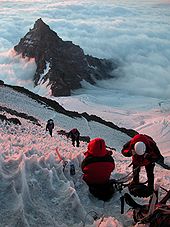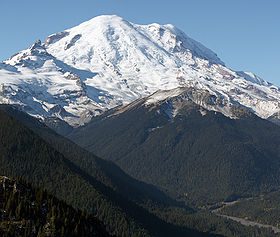Larry Zaroff
Palo Alto, California, United States
 We get to the edge. We sometimes fall off, succumbing to disease, accident, or raw nature. If we are lucky, we catch ourselves or someone pulls us back. I have been to the almost-end twice. Once in an avalanche—just freakishly fortunate—nature was kind that afternoon. Pneumonia carried me to the precipice years later. Superb medical care restored my blood pressure and salvaged my brain.
We get to the edge. We sometimes fall off, succumbing to disease, accident, or raw nature. If we are lucky, we catch ourselves or someone pulls us back. I have been to the almost-end twice. Once in an avalanche—just freakishly fortunate—nature was kind that afternoon. Pneumonia carried me to the precipice years later. Superb medical care restored my blood pressure and salvaged my brain.
I was taking a snow and ice-climbing course, a well-organized seminar monitored by the Mt. Rainier Guide Service. Recent heavy snow had deepened the mountain’s quilt. The weather was blue cold that first day our group hiked up the mountain to a Quonset hut used as a high camp, near Muir Peak, a subsidiary hill below Rainier’s summit at 14,411 feet. I was the lone physician in our class of nine, which turned out to be fortuitous.
The next morning warmed, the sun cooking the snow. What I did not know, as an amateur on a big mountain: heavy, fresh snow slides when heated. Early afternoon, roped in three groups of three, we started our practice climb on Muir Peak. The hill was beautiful, rounded, sexy, steep enough to be a challenge, requiring crampons and ice ax. I was thrilled to be in school again with students who loved the mountains as I did. What we all wanted was intimacy, not just to gaze at a peak from the distance—as if on a postcard—but to blend into the hill, snuggle, overcome resistance, be accepted for our work by the mountain.
Three groups on separate ropes, with three climbers tied to each other—we were six legged insects, as it turned out, in the wrong environment for such animals. We nine started up. I was on the first rope, tied to the leader, a prominent guide. Below me was a young woman as inexperienced as the rest of us. The going up was hard but sweet. I felt wonderful, happy. As we approached the top of Muir in a vertical dance, with the the click of crampons and the sharp noise of the ice ax crunching into hard snow, our steady rhythm disappeared with the warning shout of the lead climber, “Its going!” Thinking of his words days later, I realized his yell was simply reflex, as if having seem a bomb just above, someone had shouted, “Look out!” Forces so powerful disrespect words.
I did everything as instructed, dug in my crampons—those sharp prongs fixed to the front of my boots—and smashed my ice ax deeply into the angled face, only to be swept away—as an annoying gnat might be with a breath—down the mountainside by a tsunami of ice and snow. Discarded by the mountain, I was blasted off my perch and then pulled down by the weight of the snow, augmented by the leader, a man of more than two hundred pounds. In the last second of what I thought was the end of my life, I saw the leader tumbling past me. I was like a butterfly swept away by a tornado. As I plunged off the cliff, I dragged along the third climber with me. A second rope of three climbers fell also. The third group was lucky; the guide’s throwing his rope around a rocky outcrop prevented their descent. At the bottom, I was in a quantum field. I had no idea where I was, what my position was, where I was headed. I was disoriented. Time did not exist. Where were the others in my team relative to me?
At the bottom, chaos, but queerly quiet, beach-like in the hot, high, winter sun. Bodies in a blur, scattered in no order. Then I found myself. I was embraced, buried to the waist in easy soft snow, glasses around my neck, held by a retainer, ice ax in view a dozen feet away. Death, waiting for me in the snow, had suddenly surfaced, to be transcended by life again. A quick questioning, then joy. My initial warmth turned to hard cold, as blood pooled away from my extremities. A strange dichotomy—I felt close to death but not injured. I was in shock, unable to move for the next few minutes.

Now glasses on, I could clearly see the strewn bodies of the group around me. No one was completely buried. Among the six hurled down, one climber had sustained trauma to his shoulder, another to his knee, a third a concussion. A guide had what appeared to be a fractured ankle. Lucky. No burials. As the only one not physically hurt, I slowly recovered enough to evaluate the others. A dislocated shoulder easily reduced, a sprained knee that was painful but not immobilizing, and a head injury that did not appear serious. No complaints, everyone pleased to be alive, we helped each other up the hill back to the Quonset hut, which glowed in the sun, a Ritz Carlton to the stunned and injured. Here the lead guide splinted the fracture, mended our spirits with a hot spaghetti dinner.
The following morning we started down, met by a rescue party at the halfway point. We were supremely fortunate. The day of our accident, all of Mt. Rainier seemed to seek flatness. The mountain came to earth, multiple avalanches denuding its surfaces. On another part of the mountain, on the same day, two climbers were killed.
Nature taught me another painful lesson: Large mountains are the wolverines of geology. The dangers they bring are quick and violent, ruthless, non-sectarian in their killing instincts. Avalanches can come upon you like a sudden eclipse. You think you will never see sun again. Young, foolish, too much in love with not being ordinary, I did not hesitate, never considered stopping climbing. Youth imbeds invulnerability; surviving an avalanche, inexperienced in life, unfamiliar with personal tragedy, I was free to take further risks. I never considered my attitude selfish. Later in life I would understand fear, feel defenseless, dependant.
Forty years older, climbing only stairs, my wicked asthma had gradually worsened, culminating late one night into a shaking chill. Seven a.m. at my first awakening, instead of looking out the window at San Francisco Bay, I could not raise my head to see, nor could I get out of bed to use the bathroom. Every time I tried to sit, I would fall back, rapidly descending into unconsciousness. I had the vague thought, “I have no blood pressure.” “Call 911” were the only words I could utter to my wife. I am told the Marin County Emergency Medical Service responded with an ambulance and six strong men. Our home sits on a cliff, serviced by a tram; our bedroom lies some ninety steps from the street. The stretcher could not fit on the tiny tram. A tough carry. Bumpy, my only memory of the ambulance ride to University of California San Francisco Hospital.
Voices in the emergency room penetrated through the black swan spreading her wings over my brain: “Electrocardiogram,” “arterial line—right radial,” “central line into the internal jugular,” “Foley catheter to measure urine output,” “antibiotics.” Close to that final border, I did not object. I felt nothing—only heard the sounds of the ER. I remembered that hearing is the last sensation lost as we die. I was a prisoner of my non-existent blood pressure. Then I perceived with absolute lucidity, an authoritative voice: “start dopamine.” Dreaded dopamine, a drug I used only when my heart-surgery patients were in trouble. Then I knew how much danger I was in. Where had my blood pressure gone and why? I had a purple flash, a last thought for the next 24 hours—a synesthesia, a smell of anatomy lab, embalming fluid.
Two days later when I began to think clearly, blood pressure restored, I understood the sequence. My primary doctor, an excellent first year resident in medicine, explained: Asthma, major pneumonia, septic shock—exacerbated by my low blood volume, a result of diuretics for treating hypertension. Four days in the intensive care unit, transfer to the monitoring unit for two days, then home. Depression followed, an existential loneliness of impending death.
The avalanche was too fast, over too quickly, and I was young. I never considered where death was. But in the hospital, at 70, as I recovered from my lung infection, I considered all the deaths I had encountered in 29 years practicing cardiac surgery. Experiencing the edge myself changed me. I had thought I was invulnerable and had not considered how close we all are to falling. Nor had I valued those deaths enough, did not give them the homage that they deserved. I did not spend enough time with patients and families before surgery, nor did I offer compassion and empathy after a death. I simply accepted deaths as part of my work. Acceptance of those failures, in the context of my own encounters on the edge, was the hardest part of my healing.
Older, more thoughtful, I now examine my life from the perspective of a medical humanist and consider the future. Being close to death a second time, will I now change, alter how I spend my remaining days? Devote the rest of my life to travel, golf, leisure? No. Now I think less of myself, more of my obligations to family and students. I will continue to work, see patients, teach students, spend more time with children and grandchildren. As Sartre said, “you are what you do.” Life is too close to the edge, too easy to slip off. Time at the brink is limited.
LARRY ZAROFF, MD, PhD has had five careers following his residency and two years in the U.S. Army Surgical Research Unit. He focused for 29 years on cardiac surgery, including a stint as director of the cardiac surgical research laboratory at Harvard. There his work centered on the development of the demand pacemaker. He spent the next 10 years concentrating on climbing and did a first ascent of Chulu West, a 22,000-foot peak on the Nepal-Tibet border. His third life has been at Stanford, where he received a Ph.D. in 2000, and where he teaches courses in medical humanities. His fourth career has been as a writer for the New York Times science section. He now works one day a week as a volunteer family doctor. He has received awards as the outstanding faculty advisor for the Human Biology program and in 2006 was honored as Stanford’s Teacher of the Year.
Highlighted in Frontispiece Fall 2010 – Volume 2, Issue 3
Fall 2010 | Sections | Personal Narratives

Leave a Reply